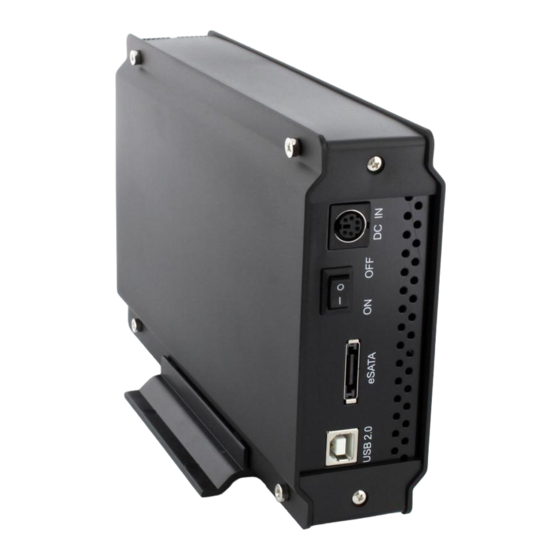Advertisement
Quick Links
Sabrent EC-UEIS7 USB 2.0/ESATA TO 3.5" IDE/SATA/SATA II ALUMINUM HARD DRIVE ENCLOSURE WITH COOLING FAN
1. Device Setup
3.5 Inch IDE Drive:
1. Check if your IDE drive has Jumpers, if so make sure they are set to Master. (Note: Please refer to the drive
manufacturer's website for more information regarding your specific hard drive model.):
2. Remove the screws, on the side without the fan, using the included screwdriver. Remove the panel:
Figure A:
Advertisement

Summary of Contents for Sabrent EC-UEIS7
- Page 1 Sabrent EC-UEIS7 USB 2.0/ESATA TO 3.5″ IDE/SATA/SATA II ALUMINUM HARD DRIVE ENCLOSURE WITH COOLING FAN 1. Device Setup 3.5 Inch IDE Drive: 1. Check if your IDE drive has Jumpers, if so make sure they are set to Master. (Note: Please refer to the drive manufacturer’s website for more information regarding your specific hard drive model.):...
- Page 2 Figure B: 3. Locate the IDE power cable. Connect it to the IDE power port on your drive: Figure A:...
- Page 3 Figure B: Figure C: 4. Locate the IDE data cable. Connect it to the IDE data port on your drive. Figure A:...
- Page 4 Figure B: Figure C: 5. Insert the hard into the enclosure, as shown below: Figure A:...
- Page 5 Figure B: 6. Place the cover back on the enclosure. Screw it back in place: Figure A:...
- Page 6 3.5 Inch SATA Drive 1. Remove the screws, on the side without the fan, using the included screwdriver. Remove the panel: Figure A: Figure B:...
- Page 7 1. Locate the SATA data port on the enclosure. Plug one end of the SATA data cable into the port. Figure A: Figure B:...
- Page 8 Figure C: Figure D:...
- Page 9 2. Locate the other end of the SATA power cable. Connect it to the SATA data port on your drive: Figure A: Figure B: Figure C:...
- Page 10 3. Remove the IDE power cable from the enclosure. Attach the SATA power cable in the same plug: Figure A: Figure B:...
- Page 11 Figure C: Figure D:...
- Page 12 4. Locate the SATA power cable. Connect it to the SATA power port on your drive: Figure A: Figure B:...
- Page 13 Figure C: 5. Insert the hard drive into the enclosure, as shown below: Figure A: Figure B:...
- Page 14 6. Place the cover back on the enclosure. Screw it back in place: Figure A: 2. Computer Setup 1. Connect the USB cable into the USB port on the enclosure. Figure A: Figure B:...
- Page 15 Alternatively, connect the E-Sata cable into the E-Sata port if you require it. (Note: E-Sata connector may be a bit difficult to plug in, and may require a bit of force to properly connect) Figure A: Figure B: 2. Connect the power cable into the power port on the enclosure. Figure A:...
- Page 16 Figure B: 3. Plug the USB or E-Sata cable into your computer’s USB or E-Sata port: 4. Flip the power switch ON: Driver Setup Windows 2000/XP/Vista/7 For Windows 2000/XP/VISTA/7, no drivers or software are necessarry. For Windows 98 SE/ ME:...
- Page 17 1. Windows will detect New Hardware, and prompt you to install driver. 2. Choose “Search for the best driver”. 3. Windows will find the necessary driver, and install them. 4. Restart your computer. 5. A new removable drive should appear in “My Computer”, assuming the drive has already been initialized. If the drive is new, then proceed to the following section.
- Page 18 4. At the following prompt, click “Next”: 5. Click “Next”:...
- Page 19 6. Assign a drive letter to the drive, then click “Next”: 7. Click on “Format this volume with the following settings:” Change the “File system” to “NTFS”. Change the “Volume label” to what you want the drive to be named. Click the checkbox for “Perform a quick format”. Click “Next”:...
- Page 20 8. Click “Finish”. Windows will now begin formatting and initializing the disk: 9. Open “My Computer” and verify that the drive shows up properly: If the drive already has data on it you can skip the previous step. 1. Check the “Device Manager” to make sure that the “USB Mass Storage Device” driver appears under the “Universal Serial Bus Controllers”...
- Page 21 Windows operating systems, up to Windows XP 64 Bit. For Windows Vista and Windows 7 you can get past this limitation, and utilize the full capacity of the drive by converting it to a GPT partition drive. http://sabrent.com/support/knowledgebase.php?article=58...
- Page 22 To convert the disk to a GPT partition disk in Windows Vista and Windows 7: Open “Disk Management”, locate the disk in the list, right click the disk and click on “Convert to GPT Disk” You will now have access to the full capacity of your 2+ TB disk.





Need help?
Do you have a question about the EC-UEIS7 and is the answer not in the manual?
Questions and answers